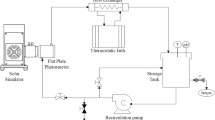Abstract
Stopped-flow technology and HPLC analysis were used to study the degradation mechanism and reaction kinetics of 4-chlorophenol (4-CP) in Fenton oxidation process. The results indicated that benzoquinone and hydroquinone were simultaneously produced in process of Fenton oxidizing 4-CP by stopped-flow technology analysis. The data obtained by HPLC showed that hydroquinone was generated in great quantities following the decrease of benzoquinone. It could be inferred by batch experiments that benzoquinone would be transformed into hydroquinone in Fenton process and hydroperoxyl radical (HO2·) would take the main part in this process. In our study, there would exist two catalytic systems in Fenton process, and one was Fe2+and Fe3+, the other was hydroquinone and benzoquinone. Moreover, the rate constants of hydroquinone, benzoquinone, and 4-chlorocatechol were 2.78 × 106 L s−1 mol−1, 9.38 × 108 L s−1 mol−1, and 6.47 × 106 L s−1 mol−1, respectively.

Graphical Abstract






Similar content being viewed by others
References
Bian, W., Song, X., Liu, D., Zhang, J., & Chen, X. (2013). Actions of nitrogen plasma in the 4-chrolophenol degradation by pulsed high-voltage discharge with bubbling gas. Chemical Engineering Journal, 219, 385–394.
Buxton, G. V., Greenstock, C. L., Helman, W. P., & Ross, A. B. (1988). Critical review of rate constants for reactions of hydrated electrons, hydrogen atoms and hydroxyl radicals (·OH/·O−) in aqueous solution. Phys. Chem. Ref. Data., 17(2), 513–886.
Chen, R. Z., Joseph, J., & Pignatell, O. (1997). Role of Quinone intermediates as electron shuttles in Fenton and photoassisted Fenton oxidations of aromatic compounds. Environmental Science & Technology, 31, 2399–2406.
Chen, F., Ma, W. H., Jianjun He, A., & Zhao, J. (2002). Fenton degradation of malachite green catalyzed by aromatic additives. Phy. Chem. A, 106(41), 9485–9490.
Du, Y., Zhou, M., & Lei, L. (2005). Reduction of Fe3+ by intermediates during Fenton oxidation ofp-chlorophenol. Journal of Chemical Industry and Engineering(China), 56(10), 1942–1947.
Du, Y., Zhou, M., & Lei, L. (2007a). The role of oxygen in the degradation of p-chlorophenol by Fenton system. Hazardous Materials, 139(1–2), 108–115.
Du, Y. X., Zhou, M. H., & Lei, L. C. (2007b). Kinetic model of 4-CP degradation by Fenton/O2 system. Water Research, 41, 1121–1133.
Glaze, W., Kang, J., & Chapin, D. (1979). Priority pollutants: a prospective view. Environmental Science & Technology, 13, 416–424.
Huang, C., Cheng, J., Wen, X., & Dai, S. (2003). Study on fast reaction kinetics of ozonation by stopped-flow spectrophotometer. Chinese Journal of Scientific Instrument, 24(4), 59–61.
Jantschko, W., Furtmüller, P. G., Zederbauer, M., Neugschwandtner, K., Jakopitsch, C., & Obinger, C. (2005). Reaction of ferrous lactoperoxidase with hydrogen peroxide and dioxygen: an anaerobic stopped-flow study. Archives of Biochemistry and Biophysics, 434(1), 51–59.
Khorassania, S. M. H., Ebrahimia, A., Maghsoodlou, M. T., Shahraki, M., Price, D., & Paknahad, A. (2015). A novel high performance stopped-flow apparatus equipped with a special constructed mixing chamber containing a plunger under inert condition with a very short dead-time to investigate very rapid reactions. Arabian Journal of Chemistry, 10, 873–884.
Lee, B. N., Lou, J. C., & Yen, P. C. (2002). Catalytic wet oxidation of 2, 4-dichlorophenolic solutions: activity of the manganese-cerium composite catalyst and biodegradability of the effluent stream. Water Environment Research, 74(1), 28–32.
Lukes, P., & Locke, B. R. (2005). Degradation of substituted phenols in hybrid gas–liquid electrical discharge reactor. Industrial and Engineering Chemistry Research, 44, 2921–2930.
Ma, J. H., Song, W. J., Chen, C. C., Ma, W. H., Zhao, J. C., & Tang, Y. L. (2005). Fenton degradation of organic compounds promoted by dyes under visible irradiation. Environmental Science and Technology, 39(15), 5810–5815.
Pera-Titus, M., García-Molina, V., Baños, M. A., Giménez, J., & Esplugas, S. (2004). Degradation of chlorophenols by means of advanced oxidation processes: a general review. Applied Catalysis B: Environmental, 47, 219–256.
Rodgers, J. D., Jedral, W., & Bunce, N. J. (1999). Electrochemical oxidation of chlorinated phenols. Environmental Science & Technology, 33(9), 1453–1457.
Wang, S. h., Yu, Y., Hou, J., & Hou, H. q. (2001). Pulse radiolysis studies on aqueous 4-chlorophenol in dilute solutions. CTA CHIMICA SINICA, 59(2), 151–153.
Zhang, Y., Zhou, M., Hao, X., & Lei, L. (2007a). Degradation mechanisms of 4-chlorophenol in a novel gas–liquid hybrid discharge reactor by pulsed high voltage system with oxygen or nitrogen bubbling. Chemosphere, 67(4), 702–711.
Zhang, Y., Zhou, M., & Lei, L. (2007b). Degradation of 4-chlorophenol in different gas–liquid electrical discharge reactors. Chemical Engineering Journal., 132, 325–333.
Acknowledgments
This study was supported by the Fundamental Research Funds for the Central Universities (2015XKMS053).
Author information
Authors and Affiliations
Corresponding authors
Electronic supplementary material
ESM 1
(DOCX 125 kb)
Rights and permissions
About this article
Cite this article
He, S., Chen, Y., Wang, H. et al. Degradation of 4-Chlorophenol by Means of Fenton Oxidation Processes: Mechanism and Kinetics. Water Air Soil Pollut 228, 284 (2017). https://doi.org/10.1007/s11270-017-3465-7
Received:
Accepted:
Published:
DOI: https://doi.org/10.1007/s11270-017-3465-7




